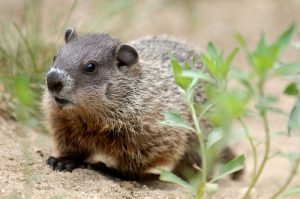Woodchuck or Groundhog – It’s the Same Pest!
By Chris Williams on June 2, 2011.
Q. I hope you can help me before it’s too late for my garden! A large, brown furry animal has been digging up my vegetable plants and chewing some off at the base. I caught a glimpse of him one evening and he was much bigger than a rat. It’s not a rabbit or a raccoon though. I tried putting out a cage trap baited with cat food, but no luck. What can I do? I was looking forward to fresh produce.
A. You might be dealing with a hungry groundhog. Whether you call it a groundhog or a woodchuck, it’s still a big pest, and I mean “big.” A groundhog can be up to 27 inches long, not counting its tail, and can weigh up to 12 pounds. An animal that big consumes a lot of food and what it mostly consumes is people’s gardens! Your cat food bait didn’t work because the groundhog is strictly a vegetarian. It feeds on grasses, weeds, clover, and also ornamental plants, garden crops (cabbage, lettuce, beans, carrots, soybeans, etc.), and fruits. Groundhogs have been known to climb trees to get to fruits such as cherries, apples, and pears. Needless to say, a groundhog in your yard can drive you crazy if you are a serious gardener or just want to enjoy a few homegrown tomatoes.
 Besides feeding on your vegetation, groundhogs are pests for another reason. They are related to squirrels and, like squirrels, gnaw or chew on things – shrubs, fruit trees, even wooden outdoor furniture, decks, and siding. They sometimes strip the bark off of trees. They have been known to damage underground cables and rubber hoses in vehicles with their gnawing.
Besides feeding on your vegetation, groundhogs are pests for another reason. They are related to squirrels and, like squirrels, gnaw or chew on things – shrubs, fruit trees, even wooden outdoor furniture, decks, and siding. They sometimes strip the bark off of trees. They have been known to damage underground cables and rubber hoses in vehicles with their gnawing.
Fortunately, groundhogs are solitary so even though the damage to your garden may look impressive, you are probably dealing with just one groundhog (if that’s any consolation). Groundhogs are active during the day, feeding mostly in the early morning or evening. If food is nearby, they range only 50 to 150 feet from their burrow. If you see one basking in the sun on a warm day, its burrow will be nearby.
To find out if the groundhog is nesting on your property, look for a burrow entrance under shrubs near your garden, or under objects like woodpiles, brush piles, sheds, porches, decks, near stone walls, even in a crawlspace. You will see a large mound of dirt by the main entrance to the burrow. There may be secondary entrances without dirt mounds. There may be a well worn trail from the burrow to…your garden. Filling in the burrow does not usually discourage a groundhog. He will simply reopen it. Young groundhogs may reoccupy unused burrows the following year.
Sounds like you need professional help. Not every pest control company can handle this type of job, but at Colonial we are experts in dealing with nuisance wildlife. We use humane measures to remove the offending animal from your property. And we can advise you on how to make your property less desirable to groundhogs in the future. Give us a call!